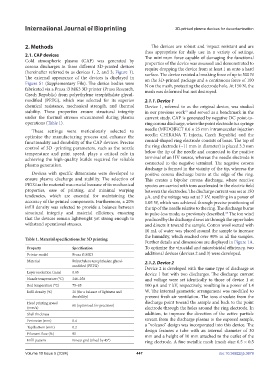Page 455 - IJB-10-5
P. 455
International Journal of Bioprinting 3D-printed plasma devices for decontamination
2. Methods The devices are robust and impact resistant and are
thus appropriate for daily use in a variety of settings.
2.1. CAP devices The minimum force capable of damaging the functional
Cold atmospheric plasma (CAP) was generated by properties of the device was assessed and demonstrated to
corona discharges in three different 3D-printed devices require dropping the device from at least 1 m onto a hard
(hereinafter referred to as devices 1, 2, and 3; Figure 1). surface. The device resisted a breaking force of up to 500 N
The external appearance of the devices is displayed in on the 3D-printed package and a continuous force of 100
Figure S1 (Supplementary File). The device bodies were N on the mesh, protecting the electrode hole. At 150 N, the
fabricated via a Prusa i3 MK3 3D printer (Prusa Research, mesh was deformed but not destroyed.
Czech Republic) from polyethylene terephthalate glycol-
modified (PETG), which was selected for its superior 2.1.1. Device 1
chemical resistance, mechanical strength, and thermal Device 1, referred to as the original device, was studied
stability. These properties ensure structural integrity in our previous work and served as a benchmark in the
19
under the thermal stresses encountered during plasma current study. CAP is generated by negative DC point-to-
operations (Table 1). ring corona discharge, where the point electrode is a syringe
These settings were meticulously selected to needle (MEDOJECT 0.6 × 25 mm intramuscular injection
optimize the manufacturing process and enhance the needle; CHIRANA T. Injecta, Czech Republic) and the
functionality and durability of the CAP devices. Precise conical-shaped ring electrode consists of brass. The top of
control of 3D -printing parameters, such as the nozzle the ring electrode (~11 mm in diameter) is placed 3.3 mm
temperature and print speed, plays a critical role in below the tip of the needle and connected to the positive
achieving the high-quality builds required for reliable terminal of an HV source, whereas the needle electrode is
plasma generation. connected to the negative terminal. The negative corona
discharge is formed in the vicinity of the tip, whereas the
Devices with specific dimensions were developed to positive corona discharge burns at the edge of the ring.
ensure plasma discharge and stability. The selection of This creates a bipolar corona discharge, where reactive
PETG as the material was crucial because of its mechanical species are carried with ions accelerated in the electric field
properties, ease of printing, and minimal warping between the electrodes. The discharge current was set at 150
tendencies, which are essential for maintaining the μA, and the voltage was set at 7 kV, resulting in a power of
accuracy of the printed components. Furthermore, a 20% 1.05 W, which was achieved through precise positioning of
infill density was selected to provide a balance between the tip of the needle relative to the ring. The discharge burns
structural integrity and material efficiency, ensuring in pulse-less mode, as previously described. The ion wind
53
that the devices remain lightweight yet strong enough to produced by the discharge draws air through the upper holes
withstand operational stresses. and directs it toward the sample. Cotton wool wetted with
10 mL of water was placed around the sample to increase
the humidity, which reached over 90% in all the samples.
Table 1. Material specifications for 3D printing
Further details and dimensions are displayed in Figure 1A.
Property Specification To optimize the virucidal and microbicidal efficiency, two
Printer model Prusa i3 MK3 additional devices (devices 2 and 3) were developed.
Material Polyethylene terephthalate glycol- 2.1.2. Device 2
modified (PETG) Device 2 is developed with the same type of discharge as
Layer resolution (mm) 0.05 device 1 but with two discharges. The discharge current
Nozzle temperature (°C) 240–250 and voltage were set identically to those of device 1 at
Bed temperature (°C) 75–85 100 μA and 7 kV, respectively, resulting in a power of 1.4
Infill density (%) 20 (for a balance of lightness and W. The internal geometric arrangement was modified to
durability) prevent fresh air ventilation. The ions circulate from the
Head printing speed 60 (optimized for precision) discharge point toward the sample and back to the point
(mm/s) electrode through the holes around the ring electrode. In
Shell thickness addition, to improve the direction of the active particle
Perimeter (mm) 0.4 stream from the discharge plasma to the exposed sample,
Top/bottom (mm) 0.2 a “volcano” design was incorporated into this device. The
design features a tube with an internal diameter of 30
Filament flow (%) 95 mm and a height of 10 mm attached to the outlet of the
Infill pattern Linear grid (tilted by 45°) ring electrode. A fine metallic mesh (mesh size: 0.5 × 0.5
Volume 10 Issue 5 (2024) 447 doi: 10.36922/ijb.3679

